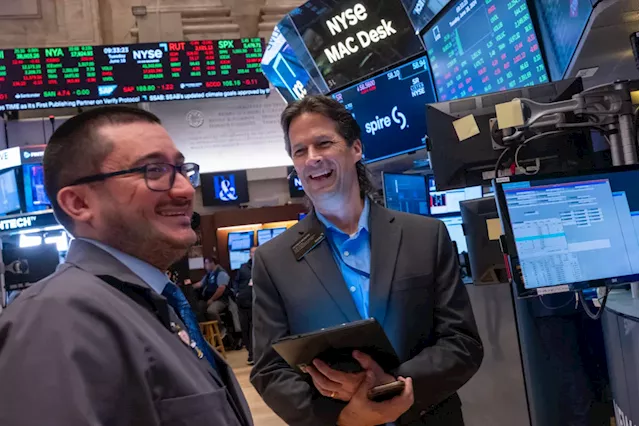) rose on Thursday after saying its earnings rose in the second quarter as it focused on cost management in a highly competitive environment, while adjusted earnings dipped.
Bell says the increased profits were due to lower other expenses, including lower buying obligations, severance and acquisition costs. It delivered 8-per-cent growth in average production despite the second quarter of each calendar year being a period of high turnaround activity for the company. Quarterly earnings from its Canadian natural gas pipelines, came in at $514-million, compared to a loss of $394-million in the year-ago period. Earnings from its Mexico pipelines were up 46.2 per cent at $266-million.
Lightspeed also said that the number of larger customer locations generating more than US$500,000 and US$1-million in gross transaction volumes increased by four per cent year over year. That segment is important for Lightspeed as it has shifted its strategy in the past two years to serving these relatively larger clients while shedding smaller customers.
“NFI delivered solid results, driven by normalizing Manufacturing activity and continued strength in Aftermarket,” said ATB Capital Markets analyst Chris Murray. “The Company confirmed that legacy contracts are now “materially completed” paving the way for a stronger recovery in H2/24 after production/delivery volumes continued to normalize in Q2/24.
“GenAI will require significant infrastructure investments to train the next generation of large foundational models and Meta is getting ahead of a multi-year capacity ramp,” J.P.Morgan analysts said. The company’s Amazon Web Services business has long dominated the cloud-computing market but it has been facing tough competition from Microsoft in recent quarters after the Windows maker rolled out AI-powered services to its Azure cloud business.
Steve Hasker, President and CEO, said in an interview after publishing financial results, “We remain highly encouraged by the customer reaction to our new AI driven products” that include generative AI products such as Westlaw AI and CoCounsel. “So far so good,” Mr. Eastwood said, pointing to the company’s sales forecast as an indication of its confidence level in generative AI yielding returns.
Executives said capital expenditure as a percentage of revenue, or what it calls capital intensity, is expected to remain at 8.5 per cent this year and at around 8 per cent for 2025 and 2026.) slid after it posted a more than 15-per-cent rise in its second-quarter profit on Thursday, as the oil and gas producer got a boost from higher crude prices, refining throughput volumes and production.
Cenovus CEO Jon McKenzie said the company is now in a position to substantially increase shareholder returns. Late Wednesday, GFL killed the prospect of a complete sale as part of its second-quarter earnings report. Because management sees strong organic growth potential, “we do not believe that taking GFL private at this time is in the best long-term interest of our shareholders,” founder and chief executive officer Patrick Dovigi said in a statement. “At its current disconnected market valuation, we are a buyer of GFL, not a seller.”However, Mr.
“ we continue to open popup stores where and when we have opportunities to do that in the right time, and really our seasonally relevant spring and summer products have helped drive strong consumer demand,” CEO Dani Reiss told Reuters. The Toronto-based group’s first-quarter revenue rose 3.3 per cent to $88.1-million, beating LSEG estimates of $86.1-million.
Business Business Latest News, Business Business Headlines
Similar News:You can also read news stories similar to this one that we have collected from other news sources.
 Stocks rebound, housing market tips: Market Domination OvertimeIn today's episode of Market Domination Overtime, hosts Josh Lipton and Julie Hyman dive into the most prominent dynamics leading stocks and the US housing...
Stocks rebound, housing market tips: Market Domination OvertimeIn today's episode of Market Domination Overtime, hosts Josh Lipton and Julie Hyman dive into the most prominent dynamics leading stocks and the US housing...
Source: YahooFinanceCA - 🏆 47. / 63 Read more »
![]() Toronto's iconic 'Leslieville dollhouse' set to hit the market on ThursdayAfter more than 50 years, Toronto's iconic 'Leslieville dollhouse' will soon have a new owner.
Toronto's iconic 'Leslieville dollhouse' set to hit the market on ThursdayAfter more than 50 years, Toronto's iconic 'Leslieville dollhouse' will soon have a new owner.
Source: CTVToronto - 🏆 9. / 84 Read more »
![]() Iconic 'Leslieville dollhouse' set to hit the market on ThursdayAfter more than 50 years, the iconic “Leslieville dollhouse” will soon have a new owner.
Iconic 'Leslieville dollhouse' set to hit the market on ThursdayAfter more than 50 years, the iconic “Leslieville dollhouse” will soon have a new owner.
Source: CTVToronto - 🏆 9. / 84 Read more »
 'Leslieville dollhouse' hits market ThursdayAfter more than 50 years, the iconic “Leslieville dollhouse” will soon have a new owner.
'Leslieville dollhouse' hits market ThursdayAfter more than 50 years, the iconic “Leslieville dollhouse” will soon have a new owner.
Source: CP24 - 🏆 30. / 67 Read more »
 Stock market news today: Stocks rally after Fed decision, Nvidia surgesA tech revival is helping lift stocks, as investors digest the Federal Reserve's decision to hold interest rates steady.
Stock market news today: Stocks rally after Fed decision, Nvidia surgesA tech revival is helping lift stocks, as investors digest the Federal Reserve's decision to hold interest rates steady.
Source: YahooFinanceCA - 🏆 47. / 63 Read more »
 Stock market news today: Stocks rally before Fed decision as Nvidia surgesA tech revival is helping lift stocks, with the Federal Reserve's rate decision on deck.
Stock market news today: Stocks rally before Fed decision as Nvidia surgesA tech revival is helping lift stocks, with the Federal Reserve's rate decision on deck.
Source: YahooFinanceCA - 🏆 47. / 63 Read more »
